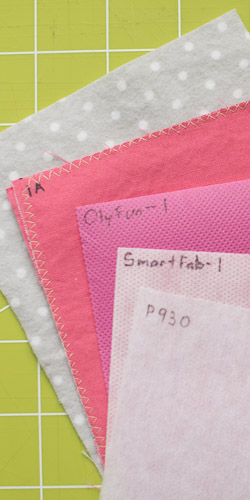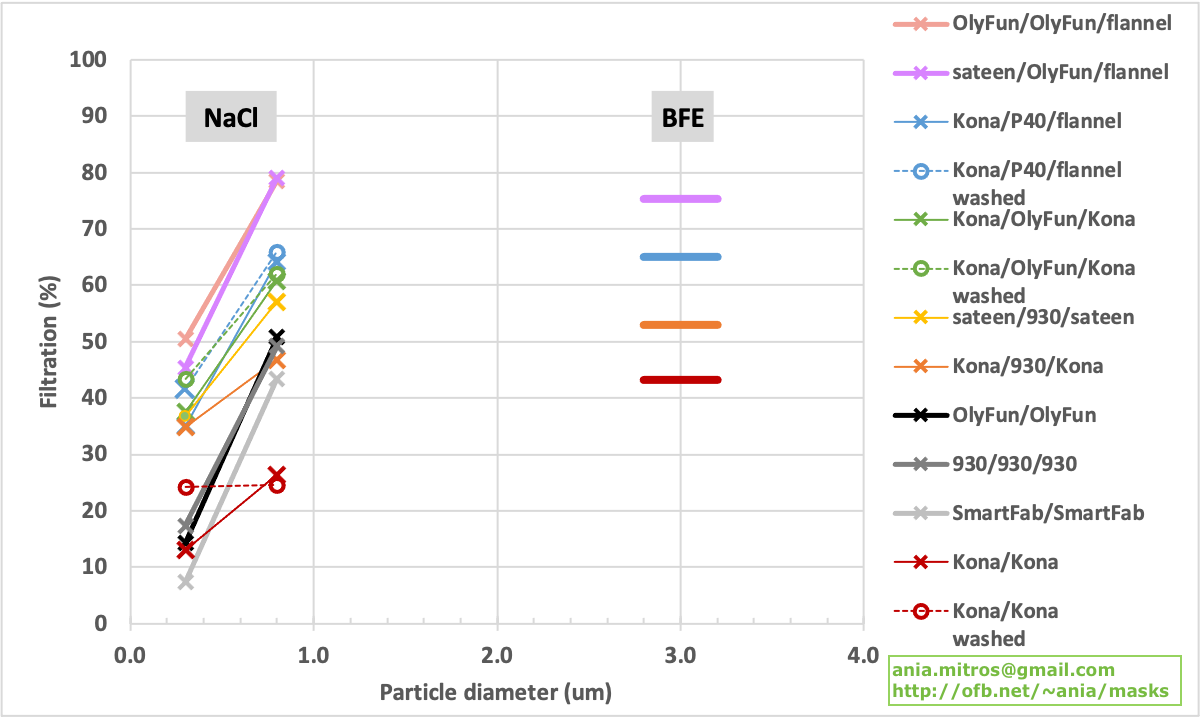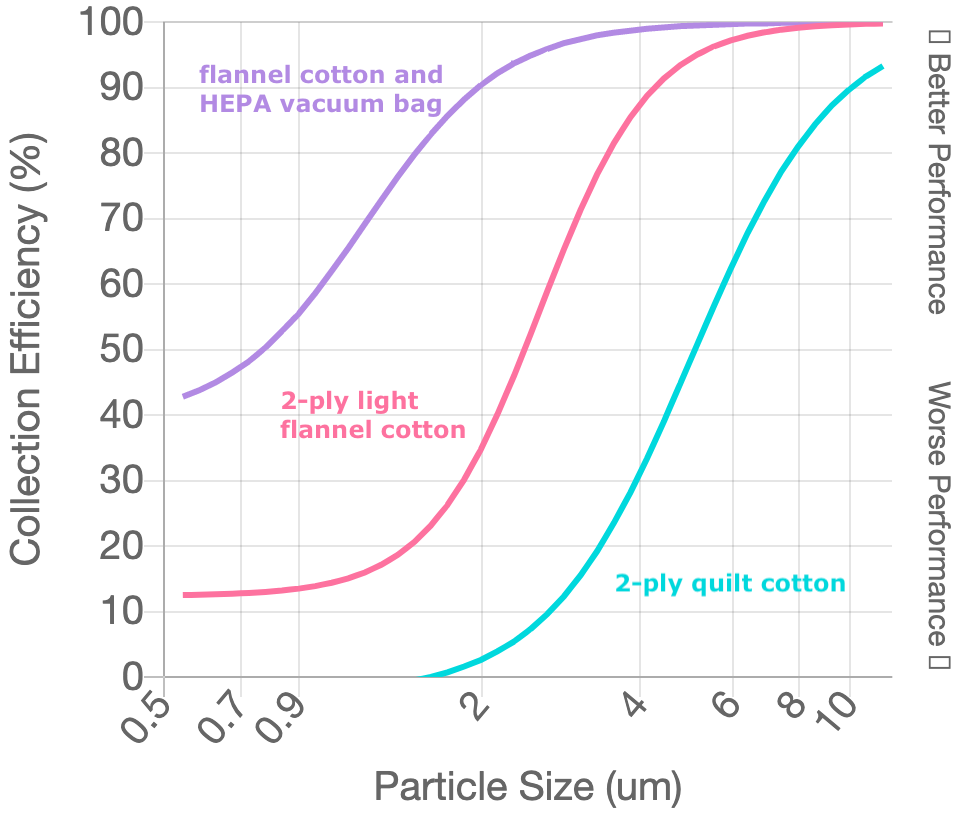Data for Sewists
Fabrics for a good mask
I cannot tell you how to make the best mask, but after reading many papers and paying to get some candidate fabrics tested... I can tell you how to make a good mask. And I have data to suport what "good" means.
Fabric filtration

Let's start with the key observations, followed by brief discussion on how to interpret the results.
- Two layers of quilting cotton (Kona) performed poorly, as expected, filtering only 26% of 0.8μm NaCl particles.
- OlyFun/OlyFun/flannel is a great combo, with nearly 80% filtration of 0.8um particles. Also, it breathes well, with a pressure drop 33% less than two cotton layers.
- Non-woven polypropylene and non-woven polyester are both worthwhile, with similar improvement in filtration if we compare the same weight material.
- Washing is fine. The 3 combos tested in both washed and unwashed versions saw no change in filtration after 10 mashine wash and dry cycles.
Let's talk details.
- Two layers of Kona performed poorly: What huh? The CDC said it's ok, and you say it ain't? The CDC recommendation was for masks as community protective equipment (CPE), not good personal protective equipment (PPE). Two layer cotton masks are decent at catching >10 μm droplets and so reduce disease spread when worn by an infected person. They catch the large, wet particles we emit. However, they are mediocre at filtering smaller, dried up droplet residue that can float in the air for seconds or minutes, and so offer middling protection for the uninfected.
- OlyFun/OlyFun/flannel is a great combo: Flannel is rockin' it. By comparing samples with and without flannel, you can back-calculate the filtration added by the flannel. My sample set allows two independent calculations, and I got 54% and 56% filtration for flannel at 0.8μm. The OlyFun non-woven polypropylene is also rockin' it, with two layers providing 49% filtration at 0.8μm.
- Non-woven polypropylene and non-woven polyester are both
worthwhile: For the same weight (in gsm or oz per square yard),
non-woven polyester (NWP) and non-woven polypropylene (NWPP)
offer similar filtration.
These non-wovens offer roughly 2 times as much filtration as Kona cotton,
with 4 to 5 times better breathability (lower pressure drop).
So whether you have access to non-woven polypropylenes (ex. OlyFun,
SmartFab) or non-woven polyester (ex. Pellon 930)
you can substantially improve your mask's filtration without
affecting breathing comfort by including these materials.
I prefer NWPP (polypropylene) to NWP (polyester) because polypropylene is hydrophobic (repels water). I find that masks with polypropylene don't get as moist as those with polyester interfacing. When I washed some NWP and NWPP and hung both to dry, the polypropylene dried remarkably more quickly.
One caveat with these non-wovens is that they are stiffer than cottons, so your mask pattern may need adjustment.
- Washing is fine. I washed 3 fabric combinations in a laundry bag through 10 normal wash cycles in my side-loading LG washer with Seventh Generation free & clear laundry detergent; each followed by a normal dry cycle in my LG dryer. The 3 combos tested in both washed and unwashed versions saw no change in filtration.
- Particle size:
Why do I mention the particle
size? Most any fabric filters well >10μm, with strong
evidence that most masks significantly reduce but do not eliminate
transmission. To eliminate transmission, with personal protection
as the goal, it seems we need to filter the 1μm - 10μm
particles as well. Fabrics tend to vary in their filtration
of 1μm particles, improving between 1μm and 10μm. A
fabric combo that filters well at 0.8μm almost certainly
filters equally well or better for larger particles. So a fabric
set that's rockin' it at 0.8μm... is simply rockin' it.
N95 respirators are tested with 0.3μm particles, which is the most difficult size to filter. While that's important for industrial environments where particles of any size may occur, there are multiple reasons to suspect that <0.5μm are insignificant to Covid transmission.

|
| Figure 1: Filtration efficiency results. CTT Group, an accredited lab, tested my fabric samples with two different types of particles, NaCl and BFE. The N95 respirator standard uses 0.3μm NaCl particles, the most difficult size to filter. Medical mask standards require BFE, Bacterial Filtration Efficiency, which uses larger particles (0.65μm to >7μm, with most particles near 3μm). While all my samples had mediocre performance with 0.3μm NaCl, some combinations performed well with 0.8μm NaCl which is a more relevant particle size for Covid transmission. BFE and 0.8μm NaCl filtration results align well, which inspires confidence. |
Breathability
The pressure drop or resistance across each sample is measured during the NaCl filtration test, allowing a comparison of relative breathability. A combination that does not breathe easily enough may be uncomfortable and prone to leak around the edges. Samples with two layers of woven cotton (sateen, Kona, or flannel) have similar breathing resistance. The non-wovens (Pellon P40, Pellon 930, OlyFun, and SmartFab) contribute relatively little to breathing resistance.
| Pressure drop during NaCl testing | ||||||
| Layers | Washed? | Resistance (mmH2O) |
||||
| OlyFun | OlyFun | Flannel | No | 4.1 | ||
| Sateen | OlyFun | Flannel | No | 6.5 | ||
| Kona | P40 | Flannel | No | 6.5 | ||
| Yes | 6.3 | |||||
| Kona | - | Kona | No | 6.1 | ||
| Yes | 6.1 | |||||
| Kona | OlyFun | Kona | No | 7.7 | ||
| Yes | 8.2 | |||||
| Kona | Pellon 930 | Kona | No | 6.0 | ||
| Sateen | Pellon 930 | Sateen | No | 5.8 | ||
| OlyFun | OlyFun | - | No | 1.5 | ||
| SmartFab Double-Thick | SmartFab Double-Thick | - | No | 1.3 | ||
| Pellon 930 | Pellon 930 | Pellon 930 | No | 0.6 | ||
Fabric selections
To allow sewists to buy the same fabrics as tested in this study, following are links to manufacturer websites.
| Link | Description | Weight | |
| Kona | Kona cotton (Camellia) | A typical 100% cotton quilting fabric widely used in the sewing community. Roughly 100μm gaps between fibers are visible in microscope photos. | 147.5 gsm
(measured) (specified: 4.35 oz per sq yard = 147.5gsm) |
| Sateen | Spoonflower Organic Cotton Sateen | 100% organic cotton, weave has smaller gaps than Kona. | 130 gsm
(Specified: 3.8 oz per square yard)
142 gsm (Measured) |
| Flannel | Robert Kaufman cotton flannel | 100% cotton flannel | 169.5 gsm
(Specified)
5 oz per sq yard |
| OlyFun | OlyFun (pink) | Non-woven polypropylene (NWPP) intended for crafting.
Some evidence suggests that NWPP makes an excellent
filter; see
https://makermask.org/masks-for-covid-literature-highlights/.
Note that regular SmartFab is only 40gsm, so layer appropriately depending on which weight you purchase. | 65 gsm
(specified) |
| SmartFab | SmartFab DoubleThick (white) | 66.5 gsm (measured) | |
| 930 | Pellon 930 sew-in midweight | A non-woven 100% polyester interfacing. My data suggests that this filters and breathes similarly to NWPP. | 41.1 gsm
(measured)
0.511m x 2m piece weighs 42g |
| P40 | Pellon 40 sew-in midweight stabilizer | A non-woven 85% polyester, 15% viscose interfacing, which Pellon incorrectly described as "100% polyester" on its webpage (!) and so I sewed with it for a while before realizing the discrepancy. |
Microscope photos of these and other fabrics are at:
ofb.net/~ania/fabrics/
Deeper data analysis
To go deeper into the data analysis, keep reading at:
| data-for-scientists.html |
Particle size

Filtration is strongly dependent on particle size. Fabrics block large particles better than small ones, as we can see in the plot on the right from the Volckens lab at Colorado State. For particles 10μm and larger, most any fabric with 2 or more layers filters really well, in the ballpark of 90%. At 0.3μm, most fabrics filter poorly. Given that both human population studies and well-controlled animal studies show that masks reduce disease transmission, we can conclude that >10μm particles are significant. Given that those studies also show only partial efficacy, we can guess that <10μm particles also matter.
Many studies of cloth masks use submicron particle sizes to test filtration by fabrics and fabric masks. This makes sense for comparisons against N95 respirators. N95 respirators are designed to protect against industrial particles which could be of any size and thus are challenged with 0.3μm particles since those are most difficult to filter. However, as Marr 2020 points out, viruses travel in droplets which also contain salt and proteins, so even dried out airborne particles likely are much larger than a single 0.1μm virus. While large particles can theoretically hold more virus, in studies that bin particles by size and then count either viral RNA or viable viruses, small particles (say, <5μm) hold more virus than larger particles. This makes some sense since large particles (10s or 100s of μm) tend to be generated in the mouth, while Covid attacks primarily the lower respiratory system where small (1um or so) particles originate.
Exactly what particle size dominates Covid transmission is an open question. The threshold for where cloth masks perform well falls smack in the range of uncertainty. Testing at 0.3μm, like an N95 respirator, likely will give us a pessimistic assessment of a fabric mask's ability to protect against Covid. Testing with 3.0μm particles, like a medical mask, likely gives a more realistic measure of effectiveness against disease. I focused on results from 0.8μm NaCl because I strongly suspect <1μm particles are not significant for Covid transmission; because 0.8μm NaCl results correlate well with 3.0μm BFE results; because the NaCl filtration test also measures the pressure drop (resistance, or breathability); because the NaCl test costs less than the BFE test; and because some aerosols professors told me that the NaCl test has better repeatability than BFE.
For more detail on particles and filtration, keep reading at:
| particle-sizes.html |
Back to Ania's Home Page